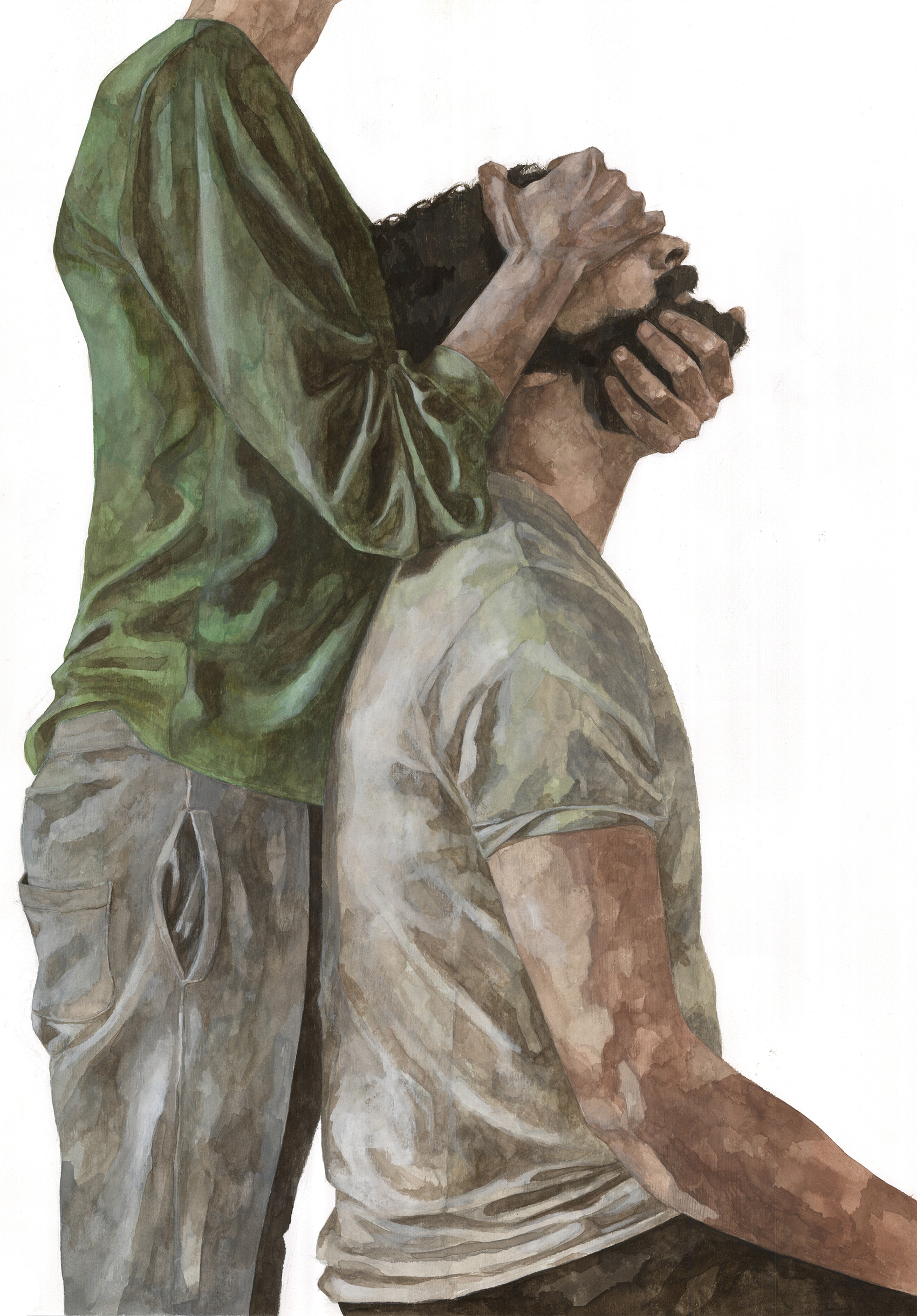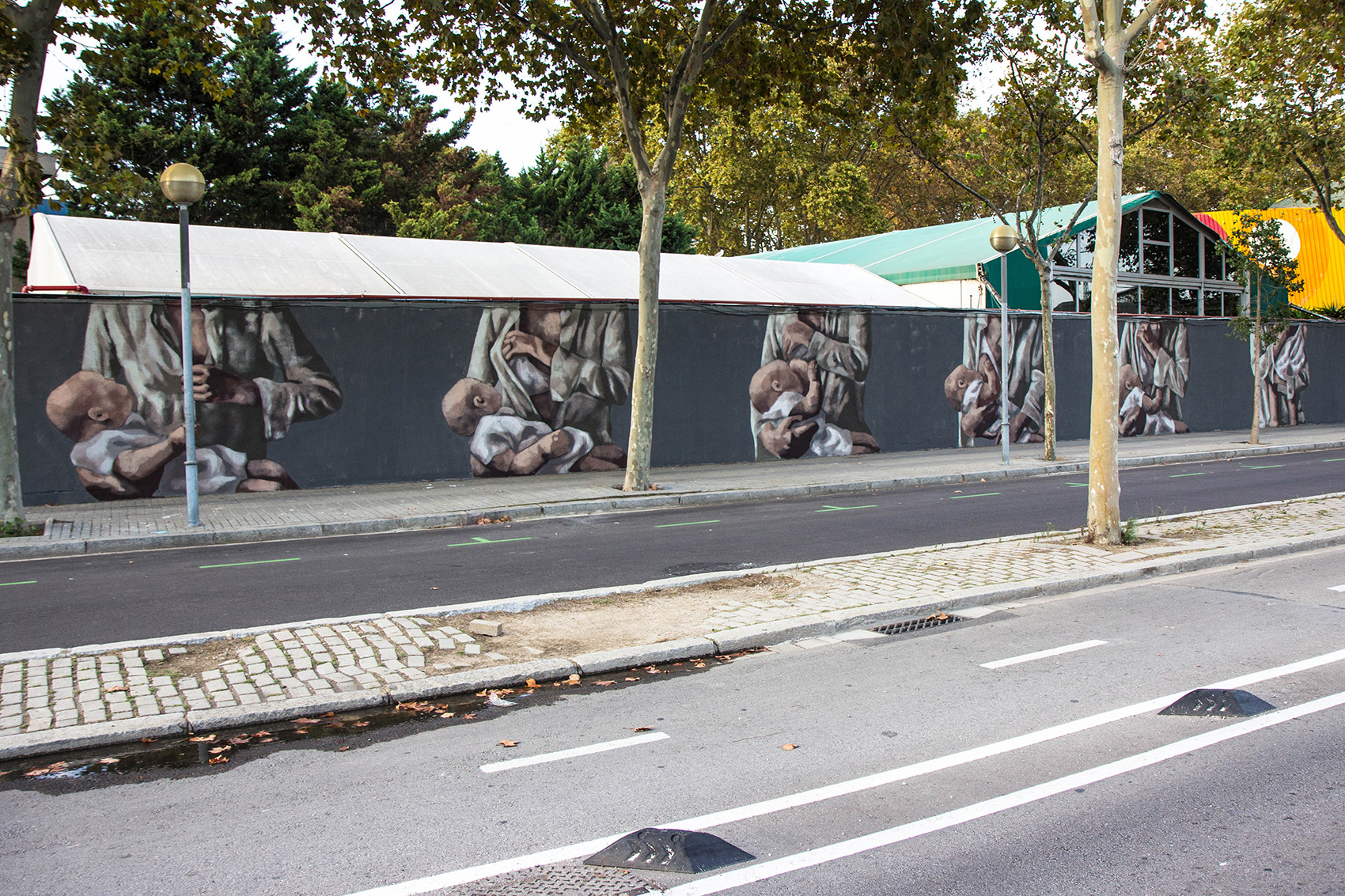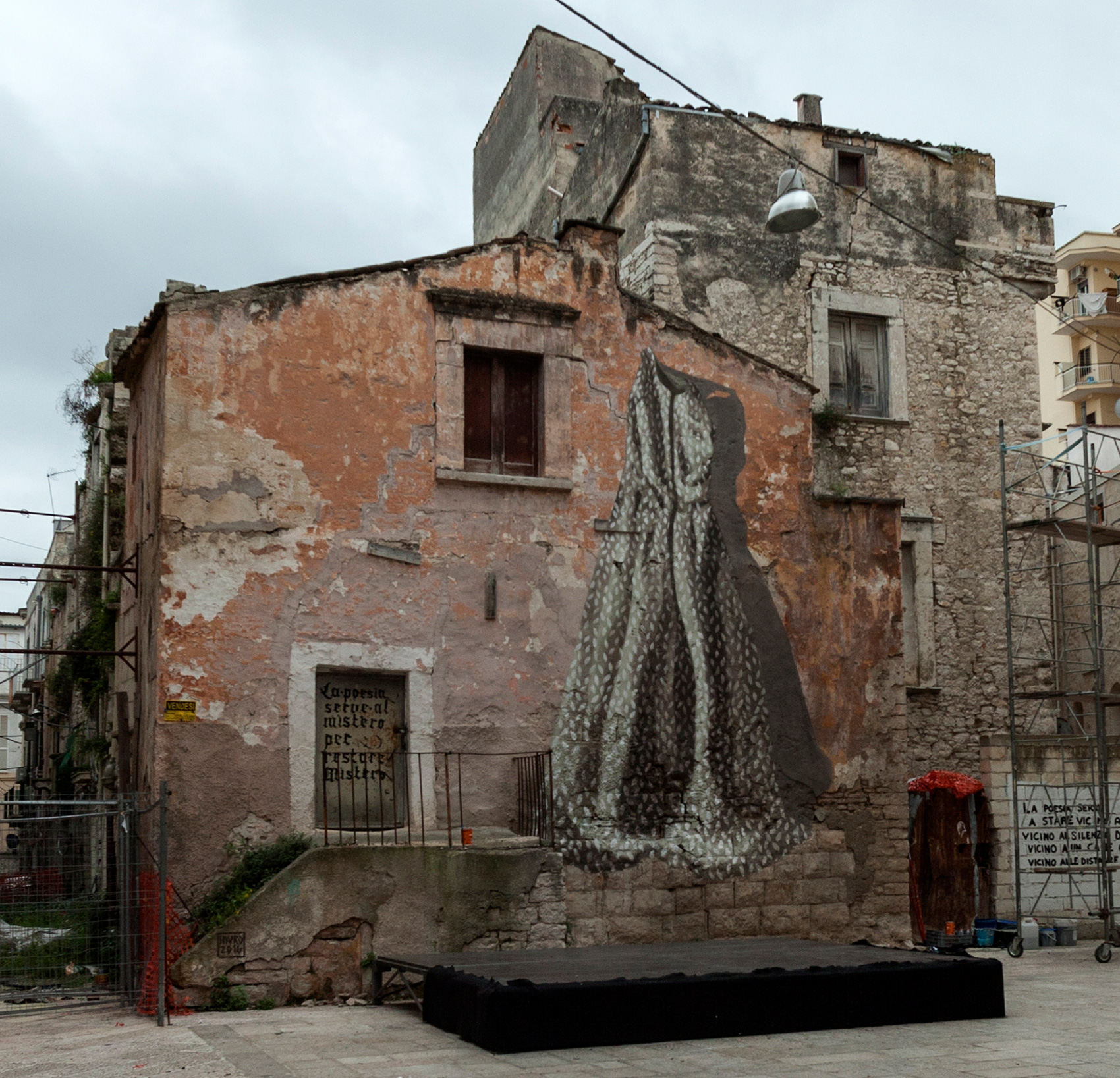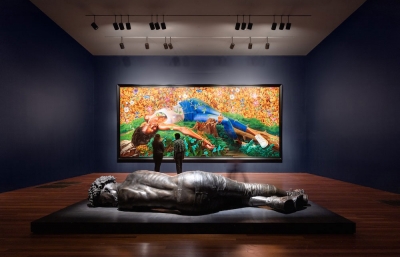Hyuro
The Present Tense
Interview by Evan Pricco // Portrait by Antonio Sena
The image contains 24 people, backs turned, gathered around and gazing up at a large brick wall. It’s unclear whether they are perplexed, contemplative, or at ease. Are they expecting something to happen? Have they demanded an action take place on the wall, behind the wall, or does the wall itself compel such a state of reflection?
Place, space and time are themes in the work of Argentina-born, Valencia, Spain-based artist Hyuro. Although known for her street works, she defies the definition of an everyday street artist, and her profoundly subtle watercolor works anchor her murals in a beautiful ambiguity that is rare to find in a genre that has grown to include some of the most popular artists of this generation. I spent a few days with Hyuro after she completed her street work for What In the World: The Juxtapoz Edition this past May in Berlin. There were questions I very much wanted to ask her; about how she approached color, why she often chose not to include faces, about the unique use of unoccupied space in many of her paintings. We found ourselves sitting in the midst of a slideshow installation at the Bauhaus Archive Museum of Design, accompanied by an eclectic, though hauntingly familiar soundtrack that included disparate pairings of songs such as Brenda Lee’s “I’m Sorry" and what sounded like a Spanish version of The Beatles "And I Love Her." There was a chance that we weren’t supposed to be conducting an entire interview here, yet this was too perfect. With place and space being so central to the discussion, this room was an oasis.
Evan Pricco: I just wanted to start this off by saying I really appreciate the space we are sitting in right now.
Hyuro: I appreciate the music.
I’m trying to figure out if there is meaning here, these old-time songs with these everyday objects just passing by on this screen. Maybe there doesn’t need to be some choreography. I don’t know why I’m looking for the meaning. It can just be pleasant. Life can be pleasant.
It’s nice when you knock down expectations, no? We are in an empty space, there is this music. It’s unexpected, it’s a space in a museum with rolling chairs where you can watch this slideshow, although it’s not what you came here for. I like that.
What I’ve noticed about your work is that you appreciate space in the way you frame it on a wall, or even as a painting.
Yes. I think it’s necessary. Especially the way we live today, I feel like thinking about the idea of space is important. I don’t know if I forced myself, or if it just came naturally to me. I think when you think of works on the street, and how we feel everything on the street, just the intensity of visuals on the street, there is something in giving back the value of empty space. This value of not doing too much. We got to a point where we thought more was better and forgot that less can be just as impactful. I’m not speaking about quality versus quantity in this case. That’s another subject to discuss, but more in respect to letting your image breathe, and having the viewer focus on one central thing. I don’t want to create distraction.

But that seems hard, to really get the viewer to just focus on this one idea. It almost seems more confrontational, or uncomfortable.
I think we need to hold onto that feeling, being uncomfortable, that sensation. I like that. It’s a good sign.
I don’t mean to imply that your work makes people uncomfortable. I’m thinking more about the difficulty of this overall concept.
Yes, I understand that, and I think this is about appreciating a feeling that we are not used to. A lot of the images that you see in a city, the advertisements, are all fabulous and about pleasure.
If I’m doing a public intervention, my intention is to connect with the people who are living there every day. There is responsibility in that. I read a lot and do research before going to any city, but I always try to verify the information with someone local. You don’t want to misrepresent how the locals see their city, to the very people who use this space every day.
Does that come with confidence?
I’m never confident enough. I get confidence later, when I see local people identifying with what they are seeing.

The fact that you don’t often show faces in your work is fascinating. It makes the viewer question who is in your paintings. Is it me? Is it her? I find myself using more literary references when I’m trying to describe your work, or trying to identify with a character. I’m imposing desired qualities on your characters, making up my own stories.
Maybe I do it unintentionally, but I don’t think of it that way. I don’t even know if I question myself, or if the work is a story. I don’t even know if I put my work in a time, which is really about time passing. It’s just a moment. It’s not about before and after. A lot of times, the work comes naturally, and then I find the meaning, which is nice that way, because then you are really interpreting your imagination. Like, for this wall in Berlin, I have never been here before, but I made an image on the wall that was more about my personal reaction to my research. I think I work more in that way. So I don’t think “on time.” Does that makes sense? I like the idea of “no time.” Time is a control.
In the end, if you don’t show time or you don’t show faces, you give more space to the viewer to finish the piece in their own mind, within their own beliefs. It doesn’t close off anything for the viewer, it doesn’t have to be this person. It keeps it open to interpretation. I just give my contribution to a place, and people can finish the meaning themselves.
We were having a side conversation where I said I think of your work as describing the future. I know a lot of visions of the future picture our world in metallics and silvers, but I think, as we dramatically shift with technology, humans are going to adopt more earthy tones. I kept thinking of the way Spike Jonze’s used colors in the movie HER. But then you mentioned a lot of people react to your work with nostalgia. I wonder, are you nostalgic?
I think maybe, yes. I have been invited a few times to paint in Italy, and one of the things they profess to like about my work is that it speaks to the past. And they mention the clothes and the colors. But I just enjoy painting the texture. I find Argentina quite nostalgic in general, the cinema, the tango. Maybe I am making connections with myself that I didn’t know were there. I lived in that history of Argentina, and in the end, it’s in me. We are our experiences, and art is an expression of who we are.
You can go two ways when you are making work that has some political and social commentary in it. You can go the way of a satirist or you can make a powerful single image with immediate impact. I think you are the latter.
I think making art is a way of getting rid of my frustration. There are great artists who work with satire; satirists. I cannot play. That’s a different kind of serious. Satirists are important but it was never my style.

You are serious about process, too.
[Laughing] It’s like I suffer too much! Maybe I should enjoy more of the process.
But why? [Laughs]
I think it’s good, at least in terms of process, to see the mistakes along the way. To see your wall when it’s completed and think about how to be better about compositions or color. It’s good to sort of suffer through the process because it’s how I learn. I can count with one hand the walls I stayed happy with just after finishing them. I am critical with myself, maybe too much.
Do you have art idols?
I think we are constructions of the things we like, of what we admire in other artists, but I always find it difficult to like every aspect of an artist’s work. Maybe if you ask me next week, my inspirations will change. Maybe I’m too strict. I can make a list of all the things I like from particular artists, but that list would be too long. I think, at this moment, I don’t distinguish between abstract and realism as I used to. When I was younger, I would definitely have drawn a line in the sand. But now I like shapes and forms. I like it all together.
I feel like we should start the interview now. How long have you been doing this mixture of street art and drawing?
When I finished my studies in Argentina and moved to Spain, I never had it in mind to do the murals, even though I always loved them. I wasn’t aware of street art, but I always loved the activist muralism movement. The Mexican movement, especially. But when I got to Spain to finish my Masters, I met people, like Escif, who were doing really interesting work in the streets, and it all felt natural. I remember him talking about what he was doing in the street, and I had never thought about doing what I was doing on canvas and putting it out onto the street. I think I painted my first wall outside in the summer of 2010.
It all came together in a crucial time in my life. I had been teaching art classes for kids, but when I started painting these walls, I didn’t know the possibilities or the opportunities that came with it—the travel, the growth, and how it allowed me to share myself to the world. It was unconscious; I think I realize now, when I look back at those early works, that it was me that I was painting. I didn’t have time to think about a “street art scene¨ or who were the other artists making work; I was just feeling comfortable in that new space of work and kept going without thinking too much. They were these difficult moments of having to make decisions; at that time, my kids were too young and I needed to think of a better way of living, but then these little things started happening that signaled that I should push myself further. My work was published on different sites and I was invited to paint at different events.
But you would have kept painting and drawing anyway, even without the attention, right?
Yeah, I wouldn’t have quit. But these signals made me go for it, to make a living of this. I love it. The freedom. To do something with all the shit that is going on with the world and maybe create a space or a piece that changes the way someone thinks about themselves. I think I would go mad if I couldn’t have an outlet for the things I take in from this world. For me, this is all necessary. These last couple of years, things started to settle a little bit more, in general, and I feel I’ve made a nice platform to get more serious and more involved. I think the more you get an equilibrium with your life, the more you can focus on things outside of yourself, and that is when the work grows and gets better.
Did being comfortable on the street have an effect on the work in the studio?
It always goes together. I think I’m getting better with a discipline now. I still sort of exist in doing things in the moment and working with ideas as they come.

Did being the only woman in several street art festivals ever strike you as interesting, or is it something that you think about?
To be honest, never. It’s something maybe I have noticed a little more because there are curators who try and create a “female street artist” show. And, as I said before, I didn’t have time to analyze street art when I first started; I just jumped right in. Maybe, after a few years later, I noticed, but to me, when I go to a festival, there is no gender. We are all artists. I don’t feel it all. But I get that it’s harder for women. Harder to make a life of traveling around if you have kids. And maybe my work addresses this idea at times; the role of women in society and what their expectations are.

Mostly, when I’m doing public art, I try to create images that make us question the system in which we live. I get a little hesitant when I go to a city or a festival and everything is painted and curated because I think we are doing exactly what we are trying to fight against. I don’t want to become the advertisement, I want to deliver another alternative message. Another reality. I’m questioning this a lot now: at what point are we becoming advertisements ourselves? I’m just trying not to contradict myself.
Follow Hyuro on Instagram at @h_y_u_r_o





